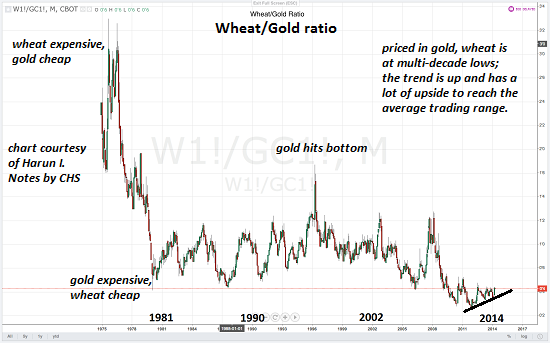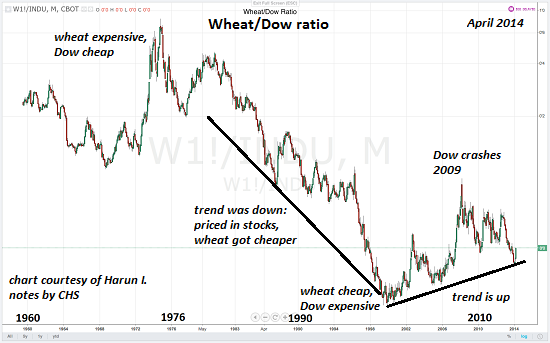Priced in Gold and stocks, London Wheat is near multi-decade lows. That may not last.
Measuring the cost of anything in currency can be misleading. As we know, inflation can be gamed by authorities to appear low, and supposedly low inflation is actually high inflation if wages are declining while prices rise.
Longtime correspondent Harun I. has often recommended in these pages that we look to other yardsticks to get a more realistic assessment of price and value.
For example, what is the cost of wheat when priced in gold rather than dollars? Harun has graciously provided a chart of the wheat/gold ratio, which I marked up to identify when gold was expensive and wheat was cheap, and vice versa.

Priced in gold, wheat is at multi-decade lows; technically, this long downtrend appears to have reversed into an uptrend. If this is so, the only direction in the price of wheat (priced in gold) is up.
Here is wheat priced in the Dow Jones Industrials Average. In essence, how many bushels of wheat can be purchased with one share of the Dow index?

In 1975, at the nadir of the stagflation-ridden stock market, wheat was expensive and the Dow cheap--once again, this is pricing wheat in the Dow, not the dollar.
At the top of the stock market bubble in 2000, the Dow was expensive and wheat was cheap.
When the Dow hit bottom in March 2009, wheat went up when priced in stock market shares.
Despite some impressive volatility since 2000, the trend in the price of wheat (when priced in stocks) is clearly up. Once again, it seems a long-term downtrend in the price of wheat has reversed and is now an uptrend.
The only way for wheat to regain its previous trading range is for gold and the Dow to both plummet or for wheat to rise in cost, i.e. it takes more gold or shares of the Dow to buy a bushel of wheat.
Priced in gold and stocks, wheat is near multi-decade lows. That may not last.Technically the trend has reversed, suggesting much higher prices--in dollars, gold or stocks--for wheat and indeed, by extension, for all food.
We may be tasting the first minimal increases in food prices that could soar to unimagined heights in the years ahead.
- English (UK)
- English (India)
- English (Canada)
- English (Australia)
- English (South Africa)
- English (Philippines)
- English (Nigeria)
- Deutsch
- Español (España)
- Español (México)
- Français
- Italiano
- Nederlands
- Português (Portugal)
- Polski
- Português (Brasil)
- Русский
- Türkçe
- العربية
- Ελληνικά
- Svenska
- Suomi
- עברית
- 日本語
- 한국어
- 简体中文
- 繁體中文
- Bahasa Indonesia
- Bahasa Melayu
- ไทย
- Tiếng Việt
- हिंदी
Relative To Gold And The Dow, Wheat Is Cheap
Published 04/25/2014, 02:06 AM
Relative To Gold And The Dow, Wheat Is Cheap
Latest comments
Loading next article…
Install Our App
Risk Disclosure: Trading in financial instruments and/or cryptocurrencies involves high risks including the risk of losing some, or all, of your investment amount, and may not be suitable for all investors. Prices of cryptocurrencies are extremely volatile and may be affected by external factors such as financial, regulatory or political events. Trading on margin increases the financial risks.
Before deciding to trade in financial instrument or cryptocurrencies you should be fully informed of the risks and costs associated with trading the financial markets, carefully consider your investment objectives, level of experience, and risk appetite, and seek professional advice where needed.
Fusion Media would like to remind you that the data contained in this website is not necessarily real-time nor accurate. The data and prices on the website are not necessarily provided by any market or exchange, but may be provided by market makers, and so prices may not be accurate and may differ from the actual price at any given market, meaning prices are indicative and not appropriate for trading purposes. Fusion Media and any provider of the data contained in this website will not accept liability for any loss or damage as a result of your trading, or your reliance on the information contained within this website.
It is prohibited to use, store, reproduce, display, modify, transmit or distribute the data contained in this website without the explicit prior written permission of Fusion Media and/or the data provider. All intellectual property rights are reserved by the providers and/or the exchange providing the data contained in this website.
Fusion Media may be compensated by the advertisers that appear on the website, based on your interaction with the advertisements or advertisers.
Before deciding to trade in financial instrument or cryptocurrencies you should be fully informed of the risks and costs associated with trading the financial markets, carefully consider your investment objectives, level of experience, and risk appetite, and seek professional advice where needed.
Fusion Media would like to remind you that the data contained in this website is not necessarily real-time nor accurate. The data and prices on the website are not necessarily provided by any market or exchange, but may be provided by market makers, and so prices may not be accurate and may differ from the actual price at any given market, meaning prices are indicative and not appropriate for trading purposes. Fusion Media and any provider of the data contained in this website will not accept liability for any loss or damage as a result of your trading, or your reliance on the information contained within this website.
It is prohibited to use, store, reproduce, display, modify, transmit or distribute the data contained in this website without the explicit prior written permission of Fusion Media and/or the data provider. All intellectual property rights are reserved by the providers and/or the exchange providing the data contained in this website.
Fusion Media may be compensated by the advertisers that appear on the website, based on your interaction with the advertisements or advertisers.
© 2007-2025 - Fusion Media Limited. All Rights Reserved.
